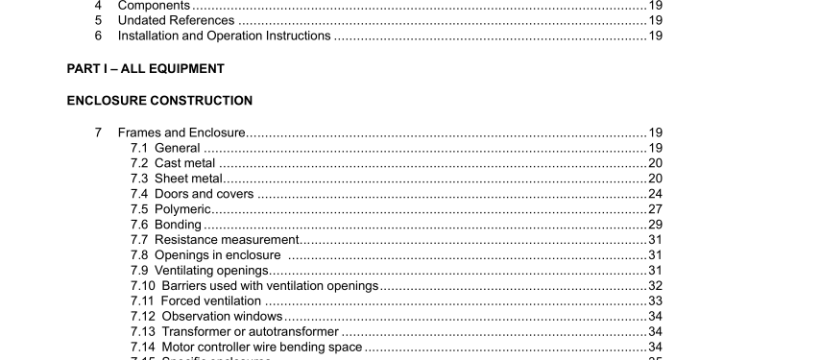UL 508-2021 pdf download.Industrial Control Equipment.
1.6 An adjustable-speed drive and accessories or modules for use with an adjustable-speed drive are covered by the Standard for i Adjustable Speed Electrical Power Drive Systems – Part 5-1: Safety Requirements – Electrical, Thermal, and Energy, UL 61800-5-1. 1.7 Equipment intended for use in hazardous locations as defined by the National Electrical Code, NFPA 70, are covered by the Standard for Explosion-Proof and Dust-Ignition-Proof Electrical Equipment for Use in Hazardous (Classified) Locations, UL 1203. 1.8 Devices that regulate temperature and/or control refrigeration equipment are covered by the Standard for Temperature-Indicating and -Regulating Equipment, UL 873, and other applicable standards. Compliance with the Standard for Automatic Electrical Controls for Household and Similar Use, Part 1: General Requirements, UL 60730-1, and/or the applicable Part 2 standard from the UL 60730 series fulfills these requirements. 1.9 Electrical instruments are covered by the Standard for Electrical Analog Instruments– Panel Board Types, UL 1437. 1.10 Products consisting of interlocked controllers and similar assemblies, intended to transfer power to a common load or output between multiple inputs or sources, are covered by the Standard for Transfer Switch Equipment, UL 1008. 1.11 Magnetic motor controllers, manual motor controllers, combination motor controllers, and overload relays are covered by the Standard for Safety for Low-Voltage Switchgear and Controlgear – Part 4-1: Contactors and Motor-Starters – Electromechanical Contactors and Motor-Starters, UL 60947-4-1.
2.7 COMPONENT FOR GROUP INSTALLATION – A motor control, overload relay, or other switching device evaluated for use in group installation. See 2.18. 2.8 CONTACTOR – A two-state (ON-OFF) device for repeatedly establishing and interrupting an electric power circuit. Interruption is obtained by introducing a gap or a very large impedance. 2.9 CONTROL CIRCUIT – A circuit that carries the electric signals directing the performance of a controller, but which does not carry the main power circuit (see IEEE Standards Dictionary of Electrical and Electronic Terms). A control circuit is generally limited to 15 amperes. 2.10 CONTROLLER – A device or group of devices that serves to govern, in some predetermined manner, the electric power delivered to the apparatus to which it is connected. 2.11 COVER – An unhinged portion of an enclosure that covers an opening. 2.12 DOOR – A hinged portion of an enclosure that covers an opening. 2.13 END-OF-LINE ENCLOSURE – An enclosure that is intended to be connected at the end of a run of conduit. 2.14 FEEDER CIRCUIT – The conductors and circuitry on the supply side of the branch circuit overcurrent protective device. 2.15 FUNCTIONAL SAFETY – Part of the overall safety of equipment or systems that depends on the correct functioning of the process, equipment, and/or safety-related control system to prevent potentially- hazardous conditions from arising or provide mitigation to reduce the severity of the hazard. 2.16 GENERAL PURPOSE RATING – This term is synonymous with “General Use Rating.”
2.23 NON-COMBINATION MOTOR CONTROLLERS – Motor control devices of the non-combination type are for use with separate protective devices, such as fuses or inverse-time circuit breakers, installed in the supply side of the motor control device. 2.24 OPEN OPERATION – An operation of closing the circuit on the test device. The letter “O” signifies this operation. 2.25 PILOT DUTY – The rating assigned to a relay or switch that controls the coil of another relay or switch. 2.26 POLE LEAST LIKELY TO STRIKE GROUND – A pole that is referenced to ground or by virtue of its position or potential or both relative to other poles of the device to be less likely than any other to strike ground. In a three pole device, this pole would usually be the middle pole. It is possible for several poles to be equally least likely to strike to ground. In this case any may be used for the test. 2.27 POLLUTION DEGREE 1 – No pollution or only dry, nonconductive pollution occurs. The pollution has no influence. 2.28 POLLUTION DEGREE 2 – Normally, only nonconductive pollution occurs; however, temporary conductivity caused by condensation may be expected. 2.29 POLLUTION DEGREE 3 – Conductive pollution occurs, or dry, nonconductive pollution occurs that becomes conductive due to condensation that is expected. 2.30 POWER CIRCUIT – Conductors and components of branch and feeder circuits.UL 508-2021 pdf download.
UL 508-2021 pdf download
